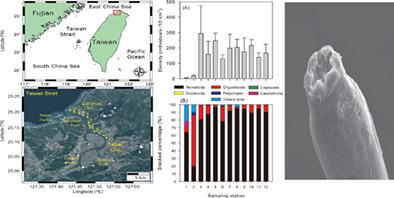当前位置:
X-MOL 学术
›
Ecol. Res.
›
论文详情
Our official English website, www.x-mol.net, welcomes your feedback! (Note: you will need to create a separate account there.)
Benthic meiofauna with emphasis on nematode assemblage response to environmental variation in the intertidal zone of the Danshuei River estuary, northwest Taiwan
Ecological Research ( IF 2 ) Pub Date : 2020-08-05 , DOI: 10.1111/1440-1703.12159 Lizhe Cai, Sujing Fu, Xiping Zhou, Li‐Chun Tseng, Jiang‐Shiou Hwang
Ecological Research ( IF 2 ) Pub Date : 2020-08-05 , DOI: 10.1111/1440-1703.12159 Lizhe Cai, Sujing Fu, Xiping Zhou, Li‐Chun Tseng, Jiang‐Shiou Hwang

|
This study aims to determine whether the benthic meiofaunal assemblages on the intertidal zone of Danshuei River estuary (DRE) in Taiwan vary from the estuary to the upper stream, and in response to different habitats. A total of six major taxa (Nematoda, Copepoda, Ostracoda, Polychaeta, Oligochaeta and Gastrotricha) of meiofauna and 44 nematode genera were recorded at 12 sampling stations in DRE in October, 2013. Meiofauna densities ranged between 4.67 ± 2.08 and 294.00 ± 180.40 ind./10 cm2, the average was 162.31 ± 84.36 ind./10 cm2. Nematodes were the dominant group (relative abundance, RA: 89.27%) in the meiofaunal community at all stations, with its assemblage in DRE dominated by nonselective deposit feeders (55.14%). There were striking differences in nematode assemblages between mangroves and mangroves with reed habitats. Pearson's correlation analysis showed that the dominances of the genera Anoplostoma, Metacylicolaimus and Deontostoma were significantly negative while Terschellingia correlated positively with salinity. These genera showed either decreasing or increasing trends at stations from the estuary to the upper stream. The dominances of the genera Megadesmolaimus and Theristus were significantly positively correlated with the proportion of sand and negatively correlated with the proportion of silt and clay. Our results indicate that salinity and sediment type influenced nematode assemblages in the DRE.
更新日期:2020-09-23



























 京公网安备 11010802027423号
京公网安备 11010802027423号